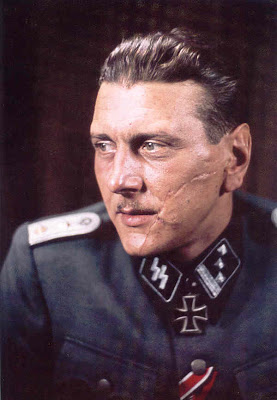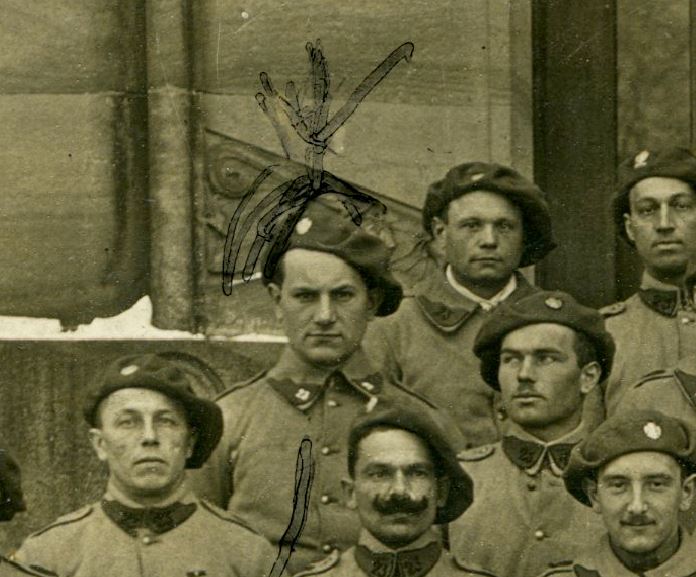It has been called THE GREAT WAR and THE WAR TO END ALL WARS.
According to Tweets from WWI, the American intervention in the war can be summarized as:
There is only room for one: ‘s idealism vs. German ‘s imperialism (US caricature).

Today, we know it as World War One (WWI). It began in 1914 and ended with an armistice at the eleventh hour of the eleventh day of the eleventh month in 1918. The global toll had already reached nearly 40 million casualties, including American losses of 117,465 dead and 204,002 wounded.
100 Years Ago Today
After War was officially declared (House and Senate) on April 6th, 1917 the U.S. began preparations to enter the quagmire of European trench warfare.

Vermonter John Corcoran (r) in WWI
In June of 1917, U.S. transport ships carrying nearly 15,000 U.S. troops (many from New England) in the American Expeditionary Force (AEF) approached the shores of France, these soldiers would join the Allied fight against the Central Powers. They disembarked at the port of Saint Nazaire; the landing site had been kept secret because of the menace of German submarines, but by the time the Americans had lined up to take their first salute on French soil, an enthusiastic crowd had gathered to welcome them. However, the “Doughboys,” as the British referred to the green American troops, were said to be untrained and ill-equipped, untested for the rigors of fighting along the Western Front.

PortraitsofWar’s WWI Smithsonian Cover
As U.S. troops landed in France, Americans were mindful of a 125+ year old debt owed that nation. France had been the colonists’ most important ally during the Revolutionary War, having supplied money, material and military brains. The Marquis de Lafayette had fought beside Patriot soldiers, equipping some of them at his own expense. He won the affection of George Washington and became a hero to the young nation. Urged on by Lafayette, France had sent ships, troops, and arms that played a key role in the Patriots’ victory. In early July 1917, the newly arrived American Expeditionary Force troops marched under the Arc de Triomphe, cheered by the people of Paris. In a ceremony at Lafayette’s tomb, where the Frenchman lies buried under dirt from Bunker Hill, an American officer lay down a wreath of pink and white roses. Another officer stepped forward, snapped a salute, and declared: “Lafayette, we are here!”

Earl F. Lavallee of Winooski, VT in Germany, 1918.
As followers of PortraitsofWar will know, we take a great pride in providing interesting and never-before-seen imagery and narration of wartime photography ranging from the American Civil War to the Korean War. In most cases, I take an authentic photograph from my personal collection and work towards uncovering various details that hopefully elucidate some aspect of the photo.
101st Ammunition Train
In this case, I worked the other way around. My familiarity with the First World War history of the State of Vermont is well known to followers of this blog as well as within my home state. One of my favorite Vermont units to serve in the war was the 101st Ammunition Train of the 26th “Yankee Division”.

Jeannine Russell (Vermont Agency of Transportation Archaeology Officer), Myself (Vermont Agency of Transportation Archaeologist) and David Schütz (Vermont State Curator) inspecting WWI flags
Only a week ago I was lucky enough to be invited into the bowels of the Vermont Historical Society storage area to inspect a series of American Civil War flags with a few colleagues of mine from work. While in the holding area I mentioned that a series of WWI groups had donated regimental flags and/or guidons to the State of Vermont in the years following the war.
Although I can be a bit fuzzy in my recollections, I apparently had my facts straight and we moved a series of shelves to uncover the aforementioned flags. As I fingered through the labels I instantly recognized the attribution: 101st flags. Please see below for a bit of insight into my recollection…

101st Ammunition Train Guidon Donation Alert, Burlington Free Press, February, 1919
Ok – So my first attempt at searching on the Library of Congress Newspaper website turned up only one reference to the flags, I kept searching (tried COLORS) and came up with this…

Flags presented
The above snippit from a 1919 Burlington Free Press article reads:
Colors Presented
War Flags and Shields Presented to State
Montpelier, Oct. 23 – The presentation of the colors and shields of the organizations from Vermont participating in the the world war occurred this evening in the State House with some 200 veterans attending and over 400 spectators in the seats of the representative hall and balcony.
The services were fitting and were attended by many of the men who have been prominent in the connection with the war. Col. F.B. Thomas presided over the exercise and the program carried out consisted of the “History of the 57th Pioneer Infantry” Capt. Ernest W. Gibson – Brattleboro
Presentation of colors – First Vermont and 57th Pioneer Infantry, Col. F. B. Thomas… History and presentation of colors of 302nd Field Artillery , Color Sergeant Albert J. Seguin of Newport.
History and presentation of 101st Ammunition Train Col. William J. Keville of Boston Mass.
Presentation of guidon, Company E. 101st Ammunition Train, Capt. Harold M. Howe of Northfield, VT.

Ca. 1919 Co. E101st Ammunition Train guidon photo (from Brennan C. Gauthier Collection)
Presentation of guidon, Company F 101st Ammunition Train, Captain McMath
Presentation of guidon, Company G, 101st Ammunition Train, Chester Mooney of Newport.
As I stated earlier, I remembered the fact that the 101st and the 302nd had presented the State of Vermont with standards and guidons from prominent units representing Vermont involvement in the war. The following photos show the results of my inquiries:

Left to Right: Jeannine Russell (Vermont Agency of Transportation Archaeology Officer), Myself (Vermont Agency of Transportation Archaeologist) an David Schütz (Vermont State Curator)
In the above photo we have just unrolled the 101st Ammunition Train guidons from their muslin cocoons. Present are representative samples of Co. C, G, F and E of the 101st. Each of these matches with the above 1919 article. How amazing is it to read a 98 year old article about a presentation and see the EXACT pieces in living color?
I’m particular excited about the Co. E guidon. I own a ratty panoramic photo taken of the unit when they returned in 1919. Click here to see ever single facial feature of the men in that group.
Ok – so here’s a photo of the guidon taken right before donation in 1919:

And here’s the guidon today (my big head is at the left edge of the frame):

WWI guidons of the 101st Ammunition Train
Also, I requested that the regimental flag of the 302nd Field Artillery be brought out for photographing. Special thanks to Jonathan Croft for being the photographer!

302nd Field Artillery
Has it really been 100 years?



















































